By Pete Vack
All photos courtesy and copyright Ferrari unless otherwise noted.
Tiresome and trite, tire degradation issues are degrading our sport.
Alonso’s loss at the Canadian Grand Prix is not just a loss for the Spaniard, but a loss for the Scuderia, the engineers, the designers, the sponsors, Fiat and Formula One. His loss is also our loss, for we are all held hostage to the same idiotic tire game that is dominating, and we think, ruining the sport. Alonso’s rapid fallback in the last few laps of the race…he lost four positions in just three laps… is not due to his lack of ability as driver, a failing engine or ill handling chassis, but solely to the lack of performance of his tires. Conversely, Hamilton’s admittedly well-deserved victory was not because he was the superior driver, but because for that particular event his team dialed in the right tire parameters to win. Tiresome and trite, tire degradation issues are degrading our sport.
We have witnessed seven different winners in seven different races, and that’s the good news. The bad news is that most often the victories have little to do with the car, chassis or driver, but everything to do with tire management. Jenson Button is probably the equal to teammate Lewis Hamilton on any given day but in Canada was actually lapped by Hamilton in the race…apparently because they couldn’t get the chassis tuned to, you guessed it, the tires. Why just one relatively low tech component of these highly complex and high tech machines should get so much attention (and often negative attention) is beyond our ken.
Yet there is a solution to this madness which afflicts only our F1 racing (can you image such a scenario at a NASCAR race? I think not). Allow only three sets of tires: 1 dry compound, 1 intermediate, and one full wet. Period. Allow only one pit stop (for they are exciting and perhaps a necessary evil). Yes, of course F1 has had similar rules before but it’s time to return to some semblance of sanity. Though fuel and tire management will always be an important part of race strategy, suddenly tire management issue will return to sane levels. Then we can get on with the real racing which is ostensibly between drivers and manufacturers as the points system will clearly have you believe. As it is, the world championship this year should go to the race team managers and pit crews. And that is NOT what racing is about.
But back to the race, which was exciting/boring and almost like old times as Vettel roared off to a convincing lead followed by the usual suspects, being Hamilton, Alonso, and Webber all in hot pursuit. Vettel’s tires lasted all of seventeen laps and with pit stop he lost the lead to Hamilton. On lap 51 Hamilton’s stop allowed Alonso to blast through and on a two stop strategy Ferrari was looking good to go the distance. That is, until his tires fell off and he was passed by Hamilton on lap 64 of the 70 lap event. Ok, we could deal with a second place as Hamilton was driving superbly, but then watched as Alonso was passed by Grosjean, Perez and Vettel in rapid order, losing a good deal of Championship and Constructors points in the process. And that may come back to haunt him and the Scuderia at the end of the year.
Whether or not Räikkönen was another victim of tire degradation is hard to tell. He drove a superb race, getting up to fourth on one set of soft compound tires, and with the tire change seemed to be able to take advantage of the time saved early on. But as in the past few races, the Finn again fell back, eventually finishing 8th while teammate Grosjean took second. Hmmm.
Rumor has it that Schumacher will be out of a job at the end of the season. He retired on lap 46 with mechanical problems. Seems that he has more bad luck nowadays than all those Andrettis put together. The question is why didn’t he have bad luck in all those seven years of world championship victories? But back luck in addition to the self imposed offs don’t make a really great combination. He’s one driver who has not had to worry much about the dreaded tire deg this year.
Despite our carping about tires, the Canadian Grand Prix was great fun to watch, primarily due to the effectiveness of DRS on this track. Many great moves were made down the DRS straight and further drove home the point that victories need not be won by astute tire management but by great cars and drivers.
Race Results
| 1 | HAMILTON | McLaren-Mercedes | 1h32m29.586s |
| 2 | GROSJEAN | Lotus-Renault | + 2.5s |
| 3 | PEREZ | Sauber-Ferrari | + 5.2s |
| 4 | VETTEL | RBR-Renault | + 7.2s |
| 5 | ALONSO | Ferrari | + 13.4s |
| 6 | ROSBERG | Mercedes | + 13.8s |
| 7 | WEBBER | RBR-Renault | + 15.0s |
| 8 | Räikkönen | Lotus-Renault | + 15.5s |
| 9 | KOBAYASHI | Sauber-Ferrari | + 24.4s |
| 10 | MASSA | Ferrari | + 25.2s |
| 11 | DI RESTA | Force India-Mercedes | + 37.6s |
| 12 | HULKENBERG | Force India-Mercedes | + 46.2s |
| 13 | MALDONADO | Williams-Renault | + 47.0s |
| 14 | RICCIARDO | STR-Ferrari | + 64.4s |
| 15 | VERGNE | STR-Ferrari | + 1 lap |
| 16 | BUTTON | McLaren-Mercedes | + 1 laps |
| 17 | SENNA | Willaims-Renault | + 1 lap |
| 18 | KOVALAINEN | Caterham-Renault | + 1 lap |
| 19 | PETROV | Caterham-Renault | + 1 lap |
| 20 | PIC | Marussia-Cosworth | + 3 laps |
| 21 | GLOCK | Marussia-Cosworth | + 14 laps, brakes |
| 22 | SCHUMACHER | Mercedes | + 27 laps, rear wing |
| 23 | DE LA ROSA | HRT-Cosworth | + 46 laps, brakes |
| 24 | KARTHIKEYAN | HRT-Cosworth | + 48 laps, brakes |
| Fastest Lap |
VETTEL | RBR-Renault | 1m15.752s |
Note – Maldonado qualified 17th, but dropped 5 grid places as penalty for an unscheduled gearbox change.
Driver’s Championship Standings
| 1 | HAMILTON | McLaren-Mercedes | 88 Points |
| 2 | ALONSO | Ferrari | 86 Points |
| 3 | VETTEL | RBR-Renault | 85 Points |
| 4 | WEBBER | RBR-Renault | 79 Points |
| 5 | ROSBERG | Mercedes | 67 Points |
| 6 | Räikkönen | Lotus-Renault | 55 Points |
| 7 | GROSJEAN | Lotus-Renault | 53 Points |
| 8 | BUTTON | McLaren-Mercedes | 45 Points |
| 9 | PEREZ | Sauber-Ferrari | 37 Points |
| 10 | MALDONADO | Williams-Renault | 29 Points |
| 11 | KOBAYASHI | Sauber-Ferrari | 21 Points |
| 12 | DI RESTA | Force India-Mercedes | 21 Points |
| 13 | SENNA | Williams-Renault | 15 Points |
| 14 | MASSA | Ferrari | 11 Points |
| 15 | HULKENBERG | Force India-Mercedes | 7 Points |
| 16 | VERGNE | STR-Ferrari | 4 Points |
| 17 | RICCIARDO | STR-Ferrari | 2 Points |
| 18 | SCHUMACHER | Mercedes | 2 Points |
Constructor’s Championship Standings
| 1 | RBR-RENAULT | 164 Points |
| 2 | McLAREN-MERCEDES | 133 Points |
| 3 | LOTUS-RENAULT | 108 Points |
| 4 | FERRARI | 97 Points |
| 5 | MERCEDES | 69 Points |
| 6 | SAUBER-FERRARI | 58 Points |
| 7 | WILLIAMS-RENAULT | 44 Points |
| 8 | FORCE INDIA-MERCEDES | 28 Points |
| 9 | STR-FERRARI | 6 Points |
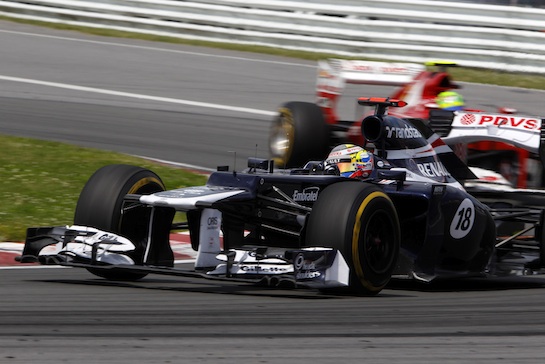
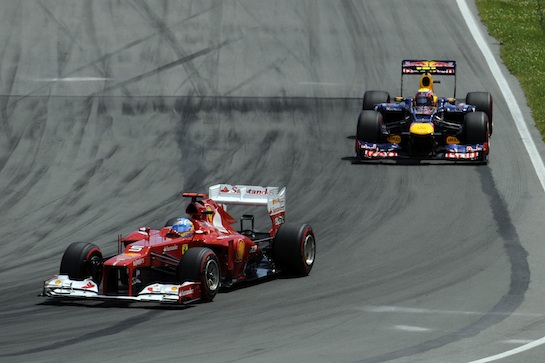
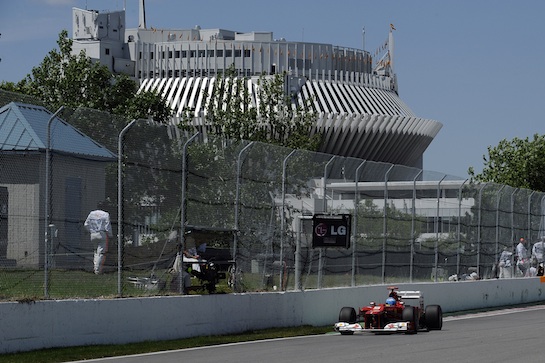
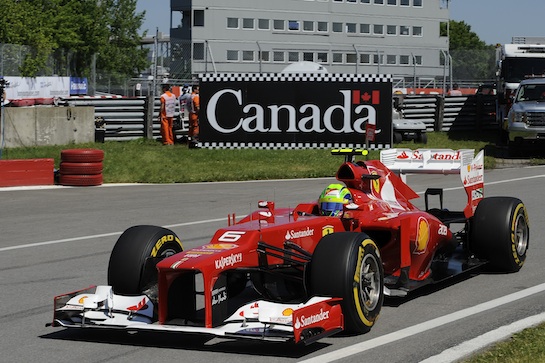
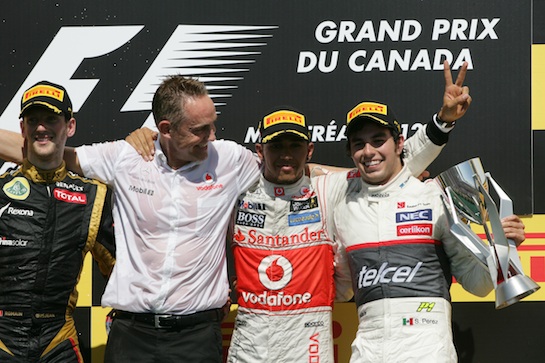

I agree. The tire thing, notwithstanding it is making racing more competitive and fun to watch, is exaggerated. We all can see that during Q3, when some divers just quit in order to save tires; I think that a championship point should be given to the pole sitter. On the other hand, every driver has the same tires and it is evidently that some of them know how to take care of their tires better than others, even Hamilton who was known to be hard on tires. Extremes, on one way or another, should be avoided.
Pete,
Sorry, I don’t agree with your tire-rant.
Canada was one of the most interesting, complicated, loosely-structured races we’ve seen in years. It was constantly in flux, with a diverse collection of contributors to the cars’ and drivers’ success or failure. It demanded constant attention to keep up with the rapid-fire shifts in position and momentum, something that the processional F1 of just a few years ago did not.
Have you forgotten the rigidly structured, predictable F1 races of the recent past? Now you want to return to them?
I find the complex interactions of team, car, driver and, yes, tires to be fascinating. Racing, and particularly F1, is a team sport that integrates the contributions of the factories, the traveling team, engineers, pit crews and even the teams’ IT crews as well as F1’s staff and officials. Those interactions are much more critical than in pretty much any other competition.
The extra element provided by tire choice and tire performance makes a positive contribution to the competition of F1 and it is better and more diverse competition for it.
You may argue that it’s ‘artificial’, but the whole spectacle is artificial, as is NASCAR, Indycar and World of Outlaws. Tire choice and management is just another element in an arbitrary environment, no more irrelevant than engine size limitations and chassis track dimensions.
Can’t agree either. It wasn’t the tires, it was poor strategy. Alonso could have pitted when Hamilton did and switched rubber and then he wouldn’t have suffered from tire degradation. Had Vettel not pitted later and changed tires he would have suffered the same fate as Alonso, rather than passing him.
This is nothing new in racing; Ferrari took a gamble a thousand other teams have previously and this time it didn’t pay off. That’s not something new; it is racing.
Couldn’t agree more. F1 is the technically superior racing series because of the heaps of silly rules. “Team sport,” my behind: the team gets the car onto the track where it should be car and driver ONLY determining who wins. Hugenholz had it right: for F1, here are your tires. The car has to fit under this box and run on gas from that station down the street. Then you’d have true and valuable technical development, not this current financial masturbatory crap. Strong letter to follow.
Agree re the tires, but also the DRS as it is just as phoney as the tires. The DRS gives the advantage to the guy behind, especially at the end of the race. DRS is fine if you can use it anytime, anywhere!
I agree that the tires are the problem.
The CARS are faster than the tires and the DRIVERS are faster than the tires.
The cars are legislated to be almost identical so a slow team can do well against a fast team strictly due to tire management – hardly a great sport!
I agree with your point of view entirely. All those legalistic or artificial “devices,” even DRS (seems like Scalextric) demean the sport significantly.
I would allow two dry compounds, but let the teams use whichever they prefer for their car, just like they do for brakes, suspension designs, etc. within established design rules. One intermediate and one full wet, d’accord also.
This being said, the GP of Canada was an exciting race and ferrari this time placed the wrong bet on pit stops. In the early season, McLaren did that a few times. So over the season, it should even out. Now, Lotus and the Iceman are owed a few…
Once again Toly has it spot on. Let the team/driver choose what tires to put on the car and when. Get rid of the silly gimmicks like DRS and KERS. Stop trying to ‘level the field’, that’s not what racing is about. It never has been and never will be. Set a displacement limit, a weight limit, pump fuel from whatever country they are racing in and as much as they want to use, whatever tire they want to use and let them race. And if the FIA wants to limit power, a rev limiter would be effective and cheap. One more thing – ban wings! Formula Gravity.
I disagree re the tires. To my mind Canada was an exciting race, but those teams who tried for a one-stop race suffered the consequences of their decision. All teams are issued the same tires, and after practice and qualification, should have a handle on the benefits and drawback of each compound. Teams and drivers that manage their tires well, do well, those that don’t, don’t.